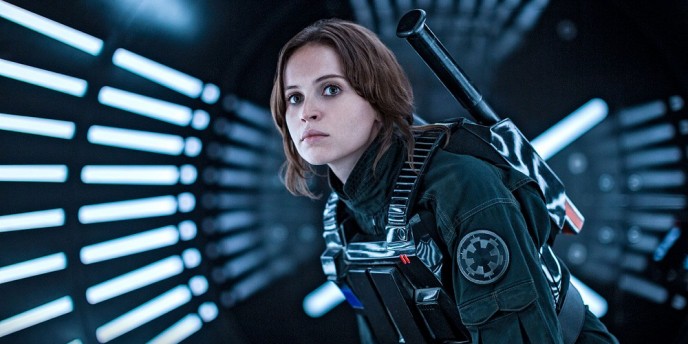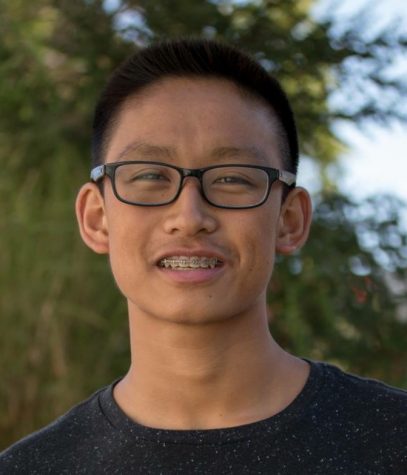“Rogue One” shoots for the stars
Photo Courtesy of pionki24
Felicity Jones stars as the strong-willed heroine Jyn Erso in Gareth Edwards’s new “Star Wars” movie.
February 2, 2017
Millions of moviegoers returned to a galaxy far, far away as “Rogue One: A Star Wars Story” was released Dec. 16 in theaters across America. Directed by Gareth Edwards and starring Felicity Jones, Diego Luna and Ben Mendelsohn, “Rogue One” is the first installment in a series of a standalone “Star Wars Anthology” films separate from the main saga.
With its PG-13 rating (the third in “Star Wars” history), “Rogue One” has a markedly darker tone than most other “Star Wars” movies. The Galactic Empire has established a tyrannical presence over the galaxy and is building a superweapon capable of destroying planets — the Death Star. The film follows protagonist Jyn Erso (Jones) on her mission to steal the Death Star plans from the Empire and transmit them to Princess Leia and the disadvantaged Rebel Alliance. Chronologically, the film takes place between the events of “Episode III — The Revenge of the Sith” and “Episode IV — A New Hope”, at a time when the Empire is at its peak.
Jones skillfully plays Erso with quiet dignity and strength evocative of Katniss Everdeen from “The Hunger Games.” Erso is an unappreciated outsider, which is intriguing because previous “Star Wars” protagonists such as Anakin Skywalker often found themselves at the center of attention. On the mission, her main partners are veteran Rebel fighter Cassian Andor (Luna) and K-2SO (Alan Tudyk), a snarky Imperial droid that has been reprogrammed to support the good guys. They are joined by several other characters/actors — Donnie Yen stands out as Chirrut Îmwe, a blind warrior monk with unwavering faith in the Force. The main villain is Orson Krennic (Mendelsohn), who directs the construction of the Death Star and is motivated by selfish ambition; in addition, an eerily realistic, CGI-generated Grand Moff Tarkin appears, along with the iconic Darth Vader.
At first, the audience is directed to a variety of locations on several different planets, while simultaneously being introduced to the main protagonists. This proves overwhelming and confusing. The main characters’ dynamic misses the mark as well — with the exception of the relationship between Îmwe (Yen) and Baze Malbus (Jiang Wen), the chemistry between the protagonists comes off as ambiguous, underdeveloped and a little forced.
This dynamic finally develops and blossoms as the plot comes full circle on the pristine beaches of Scarif. There, among tropical blue waters and palm trees, an epic battle reminiscent of the D-Day beach landing in “Saving Private Ryan” takes place. This action-packed, suspenseful ending sequence is unquestionably the best part of the film.
Despite the film’s stellar conclusion, the chemistry between the characters remains somewhat underdeveloped, and the protagonists’ convictions become less and less personal as the film progresses — but perhaps this is the point. “Rogue One” demonstrates that daunting circumstances and adversity spell the death of personal desires and relationships, a rather pessimistic testament to the trials of war.
Speaking of pessimism and the end of relationships, “Rogue One” will surely satisfy those looking for a gloomier, less idealistic movie. Violence, and the destruction caused by the Death Star, are portrayed routinely; the audience is able to see cities obliterated from the ground. The music, scored by Michael Giacchino (“Up”, “Inside Out”, “Zootopia”), is noticeably less harmonious than that of John Williams in other “Star Wars” movies — fitting in perfectly with the atmosphere created by the film’s grim, moody cinematography. The traditional leisurely opening crawl and its accompanying fanfare are absent, replaced by a single dramatically strident stab of music leading into the prologue.
Like the opening crawl, the iconic screen “wipes” of the main “Star Wars” saga (which were used as transitions) are absent as well, again adding to the gravitas and the weighty realism of Edwards’s movie.
In fact, intertextuality is not used at all — a fitting choice, considering that “Rogue One” is meant to be a standalone film. Unlike “Episode VII — The Force Awakens,” which lingered on references and exploited its Easter eggs, what little fan service “Rogue One” has is short and easily missed. Its Easter eggs are limited to brief cameos, off-screen utterances and, in one case, an interrupted remark.
One of the film’s greatest triumphs is that it effectively delivers a powerful message — that of hope. “Rogue One” transcends the narrative of hope as a moralizing, stale cliché. Instead, hope is made uncertain, constantly in doubt; furthermore, it comes at a steep price. As the destructive power of the Empire is revealed, the stakes are made much more convincing. In a memorable scene towards the end of the movie, the rebels’ last hope is literally passed like a baton in a desperately violent relay, just steps ahead of danger. From Jyn Erso’s determined resolve to Îmwe’s soft-spoken confidence, the film’s characters consistently demonstrate gritty, bold-spirited strength in the face of an overpowering evil.
“Rogue One” also transcends this narrative of good versus evil, adding a refreshing level of moral complexity to a saga that is notoriously black and white. The extremes of good and evil are still present, but Edwards explores additional themes such as extremism, privileged disillusionment and the ambiguous ethics of war. For example, the Rebellion’s “dark side” is presented with militant extremist Saw Gerrera (Forest Whitaker) who tortures suspected Imperial sympathizers, while Jyn Erso’s maligned father Galen (Mads Mikkelsen) acquiesces to work for the Empire but is actually more than meets the eye. The movie questions whether an end justifies its means, and whether one should follow orders even if such orders are immoral. The ideas are interesting, but regrettably suffer from underdevelopment as the plot progresses into more action-heavy scenes.
Overall, “Rogue One” is a solid movie that will please both first-time viewers and veteran “Star Wars” fans alike. Although it starts off rather slow, it ultimately delivers a memorable final act skillfully worked together with an emotionally riveting message. Edwards’s interpretation of “Star Wars” proves unique, deeply satisfying and definitely worth seeing. The Force is strong with this one.


